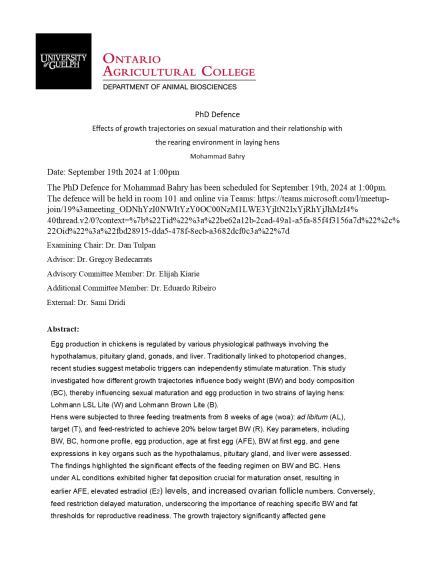Mohammad Bahry's PhD Defence
Date and Time
Location
Room 101 and teams: https://teams.microsoft.com/l/meetup-join/19%3ameeting_ODNhYzI0NWItYzY0OC00NzM1LWE3YjItN2IxYjRhYjJhMzI4%40thread.v2/0?context=%7b%22Tid%22%3a%22be62a12b-2cad-49a1-a5fa-85f4f3156a7d%22%2c%22Oid%22%3a%22fbd28915-dda5-478f-8ecb-a3682dcf0c3a%22%7d

Details
Effects of growth trajectories on sexual maturation and their relationship with the rearing environment in laying hens
Egg production in chickens is regulated by various physiological pathways involving the
hypothalamus, pituitary gland, gonads, and liver. Traditionally linked to photoperiod changes,
recent studies suggest metabolic triggers can independently stimulate maturation. This study
investigated how different growth trajectories influence body weight (BW) and body composition
(BC), thereby influencing sexual maturation and egg production in two strains of laying hens:
Lohmann LSL Lite (W) and Lohmann Brown Lite (B).
Hens were subjected to three feeding treatments from 8 weeks of age (woa): ad libitum (AL),
target (T), and feed-restricted to achieve 20% below target BW (R). Key parameters, including
BW, BC, hormone profile, egg production, age at first egg (AFE), BW at first egg, and gene
expressions in key organs such as the hypothalamus, pituitary gland, and liver were assessed.
The findings highlighted the significant effects of the feeding regimen on BW and BC. Hens
under AL conditions exhibited higher fat deposition crucial for maturation onset, resulting in
earlier AFE, elevated estradiol (E2) levels, and increased ovarian follicle numbers. Conversely,
feed restriction delayed maturation, underscoring the importance of reaching specific BW and fat
thresholds for reproductive readiness. The growth trajectory significantly affected gene
expressions related to reproductive hormones and metabolic processes. Feed restriction reduced
the expression of follicle-stimulating hormone receptor B and progesterone receptor in the
pituitary gland and vitellogenin and apolipoprotein receptors (ApoB, APOV1) in the liver.
Furthermore, the second phase of this study compared conventional cages (CC) to three aviary
styles (AV) in terms of BW, BC, and reproductive performance in W and B hens. Monitoring until
23 woa revealed CC systems promoted higher BW, with strain-specific fat deposition differences
affecting maturation and bone health.
In conclusion, these findings highlight the metabolic regulation of reproductive physiology in
laying hens, emphasizing the critical role of BC in managing egg production efficiency. Moreover,
they reveal the interaction between metabolic status, hormonal regulation, and reproductive
physiology, emphasizing the importance of optimal growth conditions. Finally, the study
emphasizes the fundamental role of housing systems in shaping physiological outcomes crucial
for the welfare and productivity of laying hens